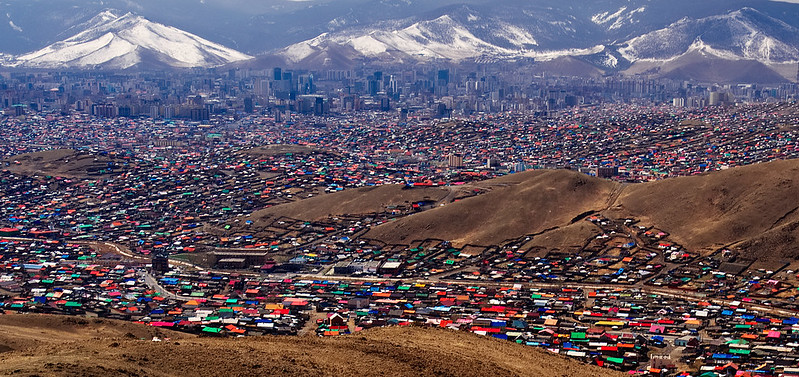By Chimguundari Navaan-Yunden and Tuvshinzaya Gantulga
Mongolia's diplomatic engagement with Central Asia and the Caucasus marks a pivotal evolution of its "third neighbor" strategy, aimed at strengthening partnerships beyond its traditional ties with Russia and China. This strategic shift has gained urgency in light of changing regional dynamics within Greater Central Asia. Since 2020, Mongolia has intensified its diplomatic activities, exemplified by presidential visits to Uzbekistan and Kazakhstan in 2024. Economic interactions, while still modest, show promising growth, notably in trade with Kazakhstan, Kyrgyzstan, and Uzbekistan, where exports have notably increased. These developments align with broader regional trends towards greater independence from Russia and China, as Central Asian countries seek to establish cooperative mechanisms. Ultimately, Mongolia's westward pivot not only enhances its sovereignty but positions it as a crucial player in promoting regional stability and cooperation in the evolving Eurasian geopolitical landscape.

BACKGROUND: Mongolia's diplomatic engagement with Central Asia and the Caucasus represents the latest evolution of its third neighbor strategy—a long-standing policy aimed at cultivating partnerships beyond Russia and China to enhance Mongolia’s sovereignty. This westward pivot has emerged as a strategic necessity for Mongolia, particularly as regional dynamics across Greater Central Asia undergo significant transformation.
Mongolia's diplomatic activity with Central Asia has accelerated markedly since 2020. High-level visits, previously sporadic, have become increasingly frequent and substantive. President Ukhnaagiin Khurelsukh's recent state visits to Uzbekistan and Kazakhstan in 2024 resulted in numerous bilateral agreements, bolstering cooperation in trade, transport, and cultural exchange. The visit to Uzbekistan yielded 14 bilateral agreements and the inauguration of Mongolia's Embassy in Tashkent. Similarly, the Kazakhstan visit established a formal strategic partnership. Mongolia's diplomatic outreach extended to Turkmenistan, marking the first bilateral presidential visits since diplomatic relations began in 1992, and to Kyrgyzstan, where bilateral relations have steadily improved following President Sadyr Japarov's 2023 visit to Mongolia and the opening of the Kyrgyz Embassy in Ulaanbaatar.
Economic engagement, while still modest, demonstrates upward momentum. Trade with Kazakhstan has reached approximately $150 million annually, with Mongolian exports of horse meat growing from $2.9 million in 2017 to $8.3 million in 2022. Kazakhstan's exports to Mongolia, primarily industrial and consumer goods, increased from approximately $72.9 million to $93 million during the same period. Mongolia's trade with Kyrgyzstan doubled from about $2 million in 2017 to over $5 million by 2022, driven by re-exported used cars and consumer goods. Trade with Uzbekistan grew dramatically from under $1 million in 2017 to nearly $10 million by 2022, focused on meat exports and Uzbek fertilizers. Meanwhile, trade with Turkmenistan and Tajikistan remains negligible. For Mongolia, with $20 billion GDP and over 90% of export goes to China, this is a significant development.
Mongolia's engagement with the Caucasus remains nascent but shows promising signs. High-level diplomatic exchanges include former President Tsakhiagiin Elbegdorj's official visits to Armenia in 2015 and Georgia in 2016, enhancing trade and cultural ties. Azerbaijan received a working visit from former President Khaltmaagiin Battulga in 2018, exploring collaborations in energy and investment. While trade volumes remain limited, recent growth is evident, particularly with Azerbaijan, where exports surged to approximately $1.6 million in 2024, primarily in livestock products.
These developments have occurred against the backdrop of emerging region-wide structures in Greater Central Asia, as countries seek to develop collective mechanisms for cooperation outside the frameworks dominated by Russia and China. Mongolia's engagement with these structures aligns with the broader regional trend toward developing greater agency and connectivity across Central Asia and the Caucasus.
IMPLICATIONS: Mongolia's deepening engagement with Central Asia and the Caucasus presents crucial economic and strategic diversification opportunities. Enhanced diplomatic and economic ties provide Mongolia with a hedge against over-reliance on China, currently its dominant trading partner, and alternative options given restrictive Western sanctions against Russia. The geographic and economic profiles of Kazakhstan and Uzbekistan, with their combined population of approximately 56 million, offer ample market opportunities for Mongolia.
Politically, Mongolia's democratic governance, a distinctive feature in the region, offers a stable and transparent framework for engagement. This reliability in governance and commitment to international norms facilitates more predictable and trustworthy partnerships in areas crucial for regional development, such as trade facilitation, infrastructure investment, and the establishment of robust legal frameworks for transport corridors. This unique identity enhances Mongolia's value to Western partners and provides a practical model for how democratic principles can support economic and strategic cooperation in a challenging geopolitical landscape. Furthermore, Mongolia's active participation in cultural events like the World Nomad Games reinforces shared heritage with Central Asian states, promoting a regional identity that bridges East and West.
The integration into regional mechanisms offers Mongolia access to emerging transport corridors, particularly the "Middle Corridor" that connects Asia to Europe without crossing Russian territory. This connectivity could mitigate Mongolia's landlocked status and provide more direct routes to global markets. The successful development of these corridors would significantly reduce Mongolia's vulnerability to geopolitical pressures from its immediate neighbors.
Central Asian and Caucasus countries benefit from Mongolia's outreach through expanded diplomatic networks and opportunities for collaborative initiatives in transport, energy, agriculture, environment and mining. Mongolia's strategic neutrality and pragmatic foreign policy approach are viewed positively in the region, enabling enhanced collaboration without triggering sensitive geopolitical responses from Russia and China.
The burgeoning regional integration subtly shifts dynamics for Russia and China. Although both powers are likely to tolerate Mongolia's increased engagement due to its non-military, primarily economic and diplomatic nature, deeper regional cooperation could eventually dilute their influence. Increased regional activity that transcends Russian and Chinese dominance, along with coordinated economic policies, could reduce regional dependency on Moscow and Beijing, leading to cautious observation from both capitals.
China's Belt and Road Initiative has significantly shaped regional infrastructure development, but Mongolia's growing ties with Central Asia introduce an alternative approach to connectivity that might circumvent Beijing's leverage. Similarly, Russia's attempts to maintain regional influence through the Eurasian Economic Union face challenges as Mongolia and Central Asian states pursue more diverse partnerships. This diversification of regional relationships represents a gradual but significant shift in the geopolitical landscape.
Mongolia's third neighbors (the U.S., EU, India, Japan, South Korea, and Turkiye) view this westward pivot positively. Strengthening Mongolia's regional ties aligns with broader Western strategic goals, including promoting stability and sovereignty in Central Asia. High-profile European visits to Mongolia, followed by tours to Central Asia (e.g., French President Emmanuel Macron’s and former UK Foreign Secretary David Cameron’s multi-leg visits), illustrate growing interest in Mongolia's bridging role. These engagements allow Western countries to enhance their regional presence without being perceived as exclusively engaging with authoritarian regimes.
The U.S., which has traditionally engaged Central Asia through the C5+1 format, could consider integrating Mongolia into this dialogue, potentially transforming it into a C6+1 arrangement. As outlined in the American Foreign Policy Council's (AFPC) April 2025 report, such integration would better reflect Mongolia's shared strategic and economic challenges with the region, particularly in critical minerals essential to global supply chains. Similarly, Japan and South Korea recognize Mongolia's potential as a gateway to continental Asia, leveraging soft power and economic investments to enhance regional integration.
CONCLUSIONS: Mongolia's pivot toward Central Asia and the Caucasus is driven by strategic necessity and presents significant opportunities for regional integration. The past years' diplomatic and economic initiatives signal genuine, albeit incremental, progress. Although concrete outcomes remain limited, the diplomatic momentum could lead to substantive cooperation in trade, transport, and infrastructure.
For Mongolia, regional integration serves as a diplomatic insurance policy, enhancing strategic autonomy amid geopolitical uncertainty. The pragmatic approach toward bilateral and multilateral cooperation mitigates potential pressure from Russia and China while strengthening ties with Western democracies. The development of region-wide structures that exclude external powers could create space for greater collective agency among the states of Greater Central Asia, including Mongolia.
Mongolia's westward orientation strategically positions it as a significant actor capable of bridging regional divides, promoting economic cooperation, and advocating democratic governance. As suggested in the AFPC’s strategy document, the emergence of a more integrated Greater Central Asia, including Mongolia, could serve as a stabilizing force across the region. Whether this evolves into more tangible regional integration or remains predominantly at the diplomatic level will significantly impact Mongolia's role in the evolving Eurasian geopolitical landscape.
The increasing American strategic interest in Greater Central Asia, with its emphasis on developing exclusive region-wide structures and enhancing connectivity, aligns with Mongolia's objectives. This convergence of interests offers Mongolia an opportunity to reinforce its sovereignty through regional integration while contributing to a more balanced regional order less dominated by Russia and China. In this evolving framework, Mongolia's distinctive political identity and strategic positioning could turn the country into an indispensable player.
AUTHORS’ BIOS: Chimguundari Navaan-Yunden is an Ambassador-at-Large and a former Foreign Policy Advisor to the Prime Minister of Mongolia. Tuvshinzaya Gantulga is a Nonresident Fellow at the Mongolian National Institute for Security Studies and a former foreign policy aide to the President of Mongolia. Both are alumni of the Central Asia-Caucasus Institute Rumsfeld Fellowship Program and members of the CAMCA Network.



